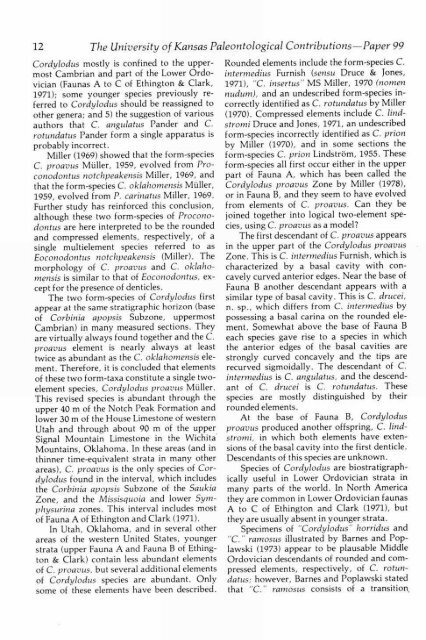View - KU ScholarWorks - University of Kansas
View - KU ScholarWorks - University of Kansas
View - KU ScholarWorks - University of Kansas
You also want an ePaper? Increase the reach of your titles
YUMPU automatically turns print PDFs into web optimized ePapers that Google loves.
12 The <strong>University</strong> <strong>of</strong> <strong>Kansas</strong> Paleontological Contributions—Paper 99<br />
Cordylodus mostly is confined to the uppermost<br />
Cambrian and part <strong>of</strong> the Lower Ordovician<br />
(Faunas A to C <strong>of</strong> Ethington & Clark,<br />
1971); some younger species previously referred<br />
to Cordylodus should be reassigned to<br />
other genera; and 5) the suggestion <strong>of</strong> various<br />
authors that C. angulatus Pander and C.<br />
rotundatus Pander form a single apparatus is<br />
probably incorrect.<br />
Miller (1969) showed that the form-species<br />
C. proavus ller, 1959, evolved from Pro<br />
tus notchpeakensis Miller, 1969, and-conodon<br />
that the form-species C. oklahomensis ller,<br />
1959, evolved from P. carinatus Miller, 1969.<br />
Further study has reinforced this conclusion,<br />
although these two form-species <strong>of</strong> Proconodontus<br />
are here interpreted to be the rounded<br />
and compressed elements, respectively, <strong>of</strong> a<br />
single multielement species referred to as<br />
Eoconodontus notchpeakensis (Miller). The<br />
morphology <strong>of</strong> C. proavus and C. oklahomensis<br />
is similar to that <strong>of</strong> Eoconodontus, except<br />
for the presence <strong>of</strong> denticles.<br />
The two form-species <strong>of</strong> Cordylodus first<br />
appear at the same stratigraphic horizon (base<br />
<strong>of</strong> Corbinia apo psis Subzone, uppermost<br />
Cambrian) in many measured sections. They<br />
are virtually always found together and the C.<br />
proavus element is nearly always at least<br />
twice as abundant as the C. oklahomensis element.<br />
Therefore, it is concluded that elements<br />
<strong>of</strong> these two form-taxa constitute a single twoelement<br />
species, Cordylodus proavus ller.<br />
This revised species is abundant through the<br />
upper 40 m <strong>of</strong> the Notch Peak Formation and<br />
lower 30 m <strong>of</strong> the House Limestone <strong>of</strong> western<br />
Utah and through about 90 m <strong>of</strong> the upper<br />
Signal Mountain Limestone in the Wichita'<br />
Mountains, Oklahoma. In these areas (and in<br />
thinner time-equivalent strata in many other<br />
areas), C. proavus is the only species <strong>of</strong> Cordylodus<br />
found in the interval, which includes<br />
the Corbinia apo psis Subzone <strong>of</strong> the Saukia<br />
Zone, and the Missisquoia and lower Symphysurina<br />
zones. This interval includes most<br />
<strong>of</strong> Fauna A <strong>of</strong> Ethington and Clark (1971).<br />
In Utah, Oklahoma, and in several other<br />
areas <strong>of</strong> the western United States, younger<br />
strata (upper Fauna A and Fauna B <strong>of</strong> Ethington<br />
& Clark) contain less abundant elements<br />
<strong>of</strong> C. proavus, but several additional elements<br />
<strong>of</strong> Cordylodus species are abundant. Only<br />
some <strong>of</strong> these elements have been described.<br />
Rounded elements include the form-species C.<br />
intermedius Furnish (sensu Druce & Jones,<br />
1971), "C. insertus" MS Miller, 1970 (nomen<br />
nudum), and an undescribed form-species incorrectly<br />
identified as C. rotundatus by Miller<br />
(1970). Compressed elements include C. lindstrotni<br />
Druce and Jones, 1971, an undescribed<br />
form-species incorrectly identified as C. prion<br />
by Miller (1970), and in some sections the<br />
form-species C. prion Lindstrôm, 1955. These<br />
form-species all first occur either in the upper<br />
part <strong>of</strong> Fauna A, which has been called the<br />
Cordylodus proavus Zone by Miller (1978),<br />
or in Fauna B, and they seem to have evolved<br />
from elements <strong>of</strong> C. proavus. Can they be<br />
joined together into logical two-element species,<br />
using C. proavus as a model?<br />
The first descendant <strong>of</strong> C. proavus appears<br />
in the upper part <strong>of</strong> the Cordylodus proavus<br />
Zone. This is C. intermedius Furnish, which is<br />
characterized by a basal cavity with concavely<br />
curved anterior edges. Near the base <strong>of</strong><br />
Fauna B another descendant appears with a<br />
similar type <strong>of</strong> basal cavity. This is C. drucei,<br />
n. sp., which differs from C. intermedius by<br />
possessing a basal caria on the rounded element.<br />
Somewhat above the base <strong>of</strong> Fauna B<br />
each species gave rise to a species in which<br />
the anterior edges <strong>of</strong> the basal cavities are<br />
strongly curved concavely and the tips are<br />
recurved sigmoidally. The descendant <strong>of</strong> C.<br />
intermedius is C. angulatus, and the descendant<br />
<strong>of</strong> C. drucei is C. rotundatus. These<br />
species are mostly distinguished by their<br />
rounded elements.<br />
At the base <strong>of</strong> Fauna B, Cordylodus<br />
proavus produced another <strong>of</strong>fspring, C. lindstromi,<br />
in which both elements have extensions<br />
<strong>of</strong> the basal cavity into the first denticle.<br />
Descendants <strong>of</strong> this species are unknown.<br />
Species <strong>of</strong> Cordylodus are biostratigraphically<br />
useful in Lower Ordovician strata in<br />
many parts <strong>of</strong> the world. In North America<br />
they are common in Lower Ordovician faunas<br />
A to C <strong>of</strong> Ethington and Clark (1971), but<br />
they are usually absent in younger strata.<br />
Specimens <strong>of</strong> -Cordylodus" horridus and<br />
"C. ramosus illustrated by Barnes and Poplawski<br />
(1973) appear to be plausable Middle<br />
Ordovician descendants <strong>of</strong> rounded and compressed<br />
elements, respectively, <strong>of</strong> C. rotundatus;<br />
however, Barnes and Poplawski stated<br />
that "C." ramosus consists <strong>of</strong> a transition.
















